+ Open data
Open data
- Basic information
Basic information
| Entry | Database: EMDB / ID: EMD-9741 | |||||||||||||||
|---|---|---|---|---|---|---|---|---|---|---|---|---|---|---|---|---|
| Title | Cryo-EM structure of Murine Norovirus S7 VLP | |||||||||||||||
 Map data Map data | Cryo-EM map of MNV-S7 VLP | |||||||||||||||
 Sample Sample |
| |||||||||||||||
 Keywords Keywords | VLP / mature / stable / VIRUS | |||||||||||||||
| Function / homology | Calicivirus coat protein C-terminal / Calicivirus coat protein C-terminal / Calicivirus coat protein / Calicivirus coat protein / virion component / Picornavirus/Calicivirus coat protein / Viral coat protein subunit / host cell cytoplasm / Capsid protein Function and homology information Function and homology information | |||||||||||||||
| Biological species |  Murine norovirus GV/NIH-2410/2005/USA / Murine norovirus GV/NIH-2410/2005/USA /  Murine norovirus GV Murine norovirus GV | |||||||||||||||
| Method | single particle reconstruction / cryo EM / Resolution: 3.5 Å | |||||||||||||||
 Authors Authors | Song C / Miyazaki N / Iwasaki K / Katayama K / Murata K / Yokoyama M / Murakami K | |||||||||||||||
| Funding support |  Japan, 4 items Japan, 4 items
| |||||||||||||||
 Citation Citation |  Journal: PLoS Pathog / Year: 2020 Journal: PLoS Pathog / Year: 2020Title: Dynamic rotation of the protruding domain enhances the infectivity of norovirus. Authors: Chihong Song / Reiko Takai-Todaka / Motohiro Miki / Kei Haga / Akira Fujimoto / Ryoka Ishiyama / Kazuki Oikawa / Masaru Yokoyama / Naoyuki Miyazaki / Kenji Iwasaki / Kosuke Murakami / ...Authors: Chihong Song / Reiko Takai-Todaka / Motohiro Miki / Kei Haga / Akira Fujimoto / Ryoka Ishiyama / Kazuki Oikawa / Masaru Yokoyama / Naoyuki Miyazaki / Kenji Iwasaki / Kosuke Murakami / Kazuhiko Katayama / Kazuyoshi Murata /  Abstract: Norovirus is the major cause of epidemic nonbacterial gastroenteritis worldwide. Lack of structural information on infection and replication mechanisms hampers the development of effective vaccines ...Norovirus is the major cause of epidemic nonbacterial gastroenteritis worldwide. Lack of structural information on infection and replication mechanisms hampers the development of effective vaccines and remedies. Here, using cryo-electron microscopy, we show that the capsid structure of murine noroviruses changes in response to aqueous conditions. By twisting the flexible hinge connecting two domains, the protruding (P) domain reversibly rises off the shell (S) domain in solutions of higher pH, but rests on the S domain in solutions of lower pH. Metal ions help to stabilize the resting conformation in this process. Furthermore, in the resting conformation, the cellular receptor CD300lf is readily accessible, and thus infection efficiency is significantly enhanced. Two similar P domain conformations were also found simultaneously in the human norovirus GII.3 capsid, although the mechanism of the conformational change is not yet clear. These results provide new insights into the mechanisms of non-enveloped norovirus transmission that invades host cells, replicates, and sometimes escapes the hosts immune system, through dramatic environmental changes in the gastrointestinal tract. | |||||||||||||||
| History |
|
- Structure visualization
Structure visualization
| Movie |
 Movie viewer Movie viewer |
|---|---|
| Structure viewer | EM map:  SurfView SurfView Molmil Molmil Jmol/JSmol Jmol/JSmol |
| Supplemental images |
- Downloads & links
Downloads & links
-EMDB archive
| Map data |  emd_9741.map.gz emd_9741.map.gz | 600.3 MB |  EMDB map data format EMDB map data format | |
|---|---|---|---|---|
| Header (meta data) |  emd-9741-v30.xml emd-9741-v30.xml emd-9741.xml emd-9741.xml | 16.3 KB 16.3 KB | Display Display |  EMDB header EMDB header |
| FSC (resolution estimation) |  emd_9741_fsc.xml emd_9741_fsc.xml | 20.7 KB | Display |  FSC data file FSC data file |
| Images |  emd_9741.png emd_9741.png | 273.5 KB | ||
| Filedesc metadata |  emd-9741.cif.gz emd-9741.cif.gz | 6 KB | ||
| Archive directory |  http://ftp.pdbj.org/pub/emdb/structures/EMD-9741 http://ftp.pdbj.org/pub/emdb/structures/EMD-9741 ftp://ftp.pdbj.org/pub/emdb/structures/EMD-9741 ftp://ftp.pdbj.org/pub/emdb/structures/EMD-9741 | HTTPS FTP |
-Validation report
| Summary document |  emd_9741_validation.pdf.gz emd_9741_validation.pdf.gz | 614.4 KB | Display |  EMDB validaton report EMDB validaton report |
|---|---|---|---|---|
| Full document |  emd_9741_full_validation.pdf.gz emd_9741_full_validation.pdf.gz | 614 KB | Display | |
| Data in XML |  emd_9741_validation.xml.gz emd_9741_validation.xml.gz | 17.6 KB | Display | |
| Data in CIF |  emd_9741_validation.cif.gz emd_9741_validation.cif.gz | 24.7 KB | Display | |
| Arichive directory |  https://ftp.pdbj.org/pub/emdb/validation_reports/EMD-9741 https://ftp.pdbj.org/pub/emdb/validation_reports/EMD-9741 ftp://ftp.pdbj.org/pub/emdb/validation_reports/EMD-9741 ftp://ftp.pdbj.org/pub/emdb/validation_reports/EMD-9741 | HTTPS FTP |
-Related structure data
| Related structure data |  6iukMC  9735C  9736C  9737C  9738C  9739C  9740C C: citing same article ( M: atomic model generated by this map |
|---|---|
| Similar structure data |
- Links
Links
| EMDB pages |  EMDB (EBI/PDBe) / EMDB (EBI/PDBe) /  EMDataResource EMDataResource |
|---|---|
| Related items in Molecule of the Month |
- Map
Map
| File |  Download / File: emd_9741.map.gz / Format: CCP4 / Size: 824 MB / Type: IMAGE STORED AS FLOATING POINT NUMBER (4 BYTES) Download / File: emd_9741.map.gz / Format: CCP4 / Size: 824 MB / Type: IMAGE STORED AS FLOATING POINT NUMBER (4 BYTES) | ||||||||||||||||||||||||||||||||||||||||||||||||||||||||||||||||||||
|---|---|---|---|---|---|---|---|---|---|---|---|---|---|---|---|---|---|---|---|---|---|---|---|---|---|---|---|---|---|---|---|---|---|---|---|---|---|---|---|---|---|---|---|---|---|---|---|---|---|---|---|---|---|---|---|---|---|---|---|---|---|---|---|---|---|---|---|---|---|
| Annotation | Cryo-EM map of MNV-S7 VLP | ||||||||||||||||||||||||||||||||||||||||||||||||||||||||||||||||||||
| Projections & slices | Image control
Images are generated by Spider. | ||||||||||||||||||||||||||||||||||||||||||||||||||||||||||||||||||||
| Voxel size | X=Y=Z: 0.86 Å | ||||||||||||||||||||||||||||||||||||||||||||||||||||||||||||||||||||
| Density |
| ||||||||||||||||||||||||||||||||||||||||||||||||||||||||||||||||||||
| Symmetry | Space group: 1 | ||||||||||||||||||||||||||||||||||||||||||||||||||||||||||||||||||||
| Details | EMDB XML:
CCP4 map header:
| ||||||||||||||||||||||||||||||||||||||||||||||||||||||||||||||||||||
-Supplemental data
- Sample components
Sample components
-Entire : Murine norovirus GV
| Entire | Name:  Murine norovirus GV Murine norovirus GV |
|---|---|
| Components |
|
-Supramolecule #1: Murine norovirus GV
| Supramolecule | Name: Murine norovirus GV / type: virus / ID: 1 / Parent: 0 / Macromolecule list: all / NCBI-ID: 463708 / Sci species name: Murine norovirus GV / Virus type: VIRUS-LIKE PARTICLE / Virus isolate: SPECIES / Virus enveloped: No / Virus empty: Yes |
|---|---|
| Host (natural) | Organism:  |
| Virus shell | Shell ID: 1 / Diameter: 400.0 Å / T number (triangulation number): 3 |
-Macromolecule #1: Major capsid protein VP1
| Macromolecule | Name: Major capsid protein VP1 / type: protein_or_peptide / ID: 1 / Number of copies: 3 / Enantiomer: LEVO |
|---|---|
| Source (natural) | Organism:  Murine norovirus GV/NIH-2410/2005/USA Murine norovirus GV/NIH-2410/2005/USA |
| Molecular weight | Theoretical: 58.833785 KDa |
| Recombinant expression | Organism:  Baculovirus expression vector pFastBac1-HM Baculovirus expression vector pFastBac1-HM |
| Sequence | String: MRMSDGAAPK ANGSEASGQD LVPTAVEQAV PIQPVAGAAL AAPAAGQINQ IDPWIFQNFV QCPLGEFSIS PRNTPGEILF DLALGPGLN PYLAHLSAMY TGWVGNMEVQ LVLAGNAFTA GKVVVALVPP YFPKGSLTTA QITCFPHVMC DVRTLEPIQL P LLDVRRVL ...String: MRMSDGAAPK ANGSEASGQD LVPTAVEQAV PIQPVAGAAL AAPAAGQINQ IDPWIFQNFV QCPLGEFSIS PRNTPGEILF DLALGPGLN PYLAHLSAMY TGWVGNMEVQ LVLAGNAFTA GKVVVALVPP YFPKGSLTTA QITCFPHVMC DVRTLEPIQL P LLDVRRVL WHATQDQEES MRLVCMLYTP LRTNSPGDES FVVSGRLLSK PAADFNFVYL TPPIERTIYR MVDLPVLQPR LC THARWPA PIYGLLVDPS LPSNPQWQNG RVHVDGTLLG TTPVSGSWVS CFAAEAAYEF QSGIGEVATF TLIEQDGSAY VPG DRAAPL GYPDFSGQLE IEVQTETTKK GEKLKVTTFE MILGPTTNVD QVPYQGRVYA SLTAAASLDL VDGRVRAVPR SVYG FQDVV PEYNDGLLVP LAPPIGPFLP GEVLLRFRTY MRQIDSTDAA AEAIDCALPQ EFVSWFASNA FTVQSEALLL RYRNT LTGQ LLFECKLYSE GYIALSYSGS GPLTFPTDGF FEVVSWVPRL YQLASVGSLA TGRTLKQ UniProtKB: Capsid protein |
-Experimental details
-Structure determination
| Method | cryo EM |
|---|---|
 Processing Processing | single particle reconstruction |
| Aggregation state | particle |
- Sample preparation
Sample preparation
| Buffer | pH: 7.4 |
|---|---|
| Sugar embedding | Material: amorphous ice |
| Vitrification | Cryogen name: ETHANE / Chamber humidity: 95 % / Chamber temperature: 277 K |
- Electron microscopy
Electron microscopy
| Microscope | FEI TITAN KRIOS |
|---|---|
| Temperature | Min: 76.0 K / Max: 77.0 K |
| Image recording | Film or detector model: FEI FALCON II (4k x 4k) / Digitization - Dimensions - Width: 4096 pixel / Digitization - Dimensions - Height: 4096 pixel / Digitization - Frames/image: 3-31 / Number real images: 2746 / Average exposure time: 2.0 sec. / Average electron dose: 40.0 e/Å2 |
| Electron beam | Acceleration voltage: 300 kV / Electron source:  FIELD EMISSION GUN FIELD EMISSION GUN |
| Electron optics | C2 aperture diameter: 100.0 µm / Illumination mode: FLOOD BEAM / Imaging mode: BRIGHT FIELD / Cs: 0.1 mm / Nominal defocus max: 2.5 µm / Nominal defocus min: 1.0 µm / Nominal magnification: 75000 |
| Sample stage | Specimen holder model: FEI TITAN KRIOS AUTOGRID HOLDER / Cooling holder cryogen: NITROGEN |
| Experimental equipment |  Model: Titan Krios / Image courtesy: FEI Company |
+ Image processing
Image processing
-Atomic model buiding 1
| Refinement | Space: REAL / Protocol: FLEXIBLE FIT / Overall B value: 157 |
|---|---|
| Output model |  PDB-6iuk: |
 Movie
Movie Controller
Controller




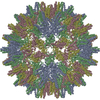
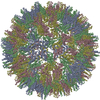



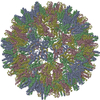


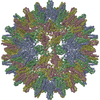

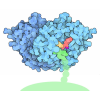
 Z (Sec.)
Z (Sec.) Y (Row.)
Y (Row.) X (Col.)
X (Col.)






















